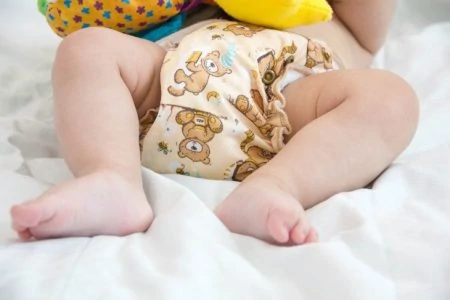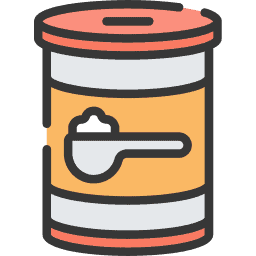Do you have a stash of cloth diapers but no idea how to get them ready for your baby?
Unlike their disposable counterparts, cloth diapers require some prep work before use. This prep can vary, and the task can seem a little daunting — especially if you are new to cloth diapering. It felt this way for us too.
But don’t worry. We’ve got your butt covered. We’ve done this many times now and have gleaned a wealth of info from other cloth diaper users.
In this article, we will answer all your questions about how to prep your cloth diapers so you won’t be in a panic when your baby arrives.
Key Takeaways
- Cloth diapers need prepping to increase absorbency and remove oils, dirt, or grime.
- Synthetic diapers (microfiber, microfleece, polyester) require only one hot wash and dry cycle.
- Natural fiber diapers (cotton, hemp) need multiple hot wash and dry cycles to remove natural oils.
- Special circumstances: bamboo and diaper covers can be prepped like synthetic diapers, while pre-loved diapers need a bleach soak and hot wash with detergent.
Why Prep Your Cloth Diapers?
You might be asking yourself if you really need to prep your cloth diapers. The answer to that question is a resounding yes. Unlike disposable diapers, cloth diapers do not come ready to wear.
Right out of the package, most cloth diapers are not at their full absorbency, especially diapers made out of natural fibers. These types of diapers hold oils within the fibers. These oils can also deposit onto other diapers, making them all repel liquid.
Even though diapers made from synthetic fibers do not have natural oils in them, they still need to be prepped before they go on your baby’s bottom. Prepping will take away any dirt and grime that may have accumulated on your diapers during manufacturing or shipping and open the fibers so that they become more absorbent.
Natural or Synthetic Fibers
So, you have your stash of diapers. Some might be made from synthetic fibers; some might be made from natural. You might assume you can prep them together, but don’t go running to the washing machine just yet. This is a hotly debated topic in the cloth diaper world.
On one side of the debate is the separation group. They believe if you prep your synthetic diapers together with the natural-fiber ones, the oils from the natural-fiber diapers will seep into the others and cause them to repel moisture. So, this group chooses to prep each type separately.
The other side of the debate is the group of people who choose to prep their diapers together. They believe if you use a good quality detergent, it will keep the oils from seeping into the synthetic-fiber diapers.
What You Need To Know
How to Prep Cloth Diapers
It’s up to you whether you prep your diapers together or separately. But how do you do it?
Here are instructions for prepping your cloth diapers.
1. Synthetic
Synthetic diapers include diapers made from microfiber, microfleece, polyester, microsuede, and other similar fabrics. These diapers are the simplest to prep because you don’t need to wash them more than once. They come already absorbent, so all you need to do is get off the dust and grime.
To prep synthetic diapers, run them through one wash cycle on the hottest water setting possible. Use the recommended amount of cloth-diaper-safe detergent, then dry in the dryer. That’s all it takes for these cloth diapers to be ready to use!
2. Natural
Diapers made from natural fibers, such as cotton and hemp, take a bit more work to prep before they are ready to use on your baby. The natural oils need to be washed out of them as much as possible to ensure they are absorbent and won’t simply repel your baby’s urine.
To prep natural-fiber diapers, wash them several times in hot water with cloth-diaper-safe detergent.
Here's What I Do
Your baby can wear the diapers before they have reached their full absorbency. But be prepared that the diaper might leak until it has gone through a few more wash cycles.
Special Circumstances
The fiber content isn’t the only thing we have to worry about when prepping cloth diapers. Thankfully, the process is not very complicated.
Here are a few more scenarios you might run into.
1. Bamboo
Fun fact: when bamboo is converted from its natural form into fabric for your diapers, it becomes rayon, a natural-synthetic hybrid. So, how do you prep bamboo cloth diapers?
Most moms treat bamboo diapers like other synthetic options since the natural oils are removed during processing. So, all you need to do before using them is wash them once in hot water with detergent, then dry them in the dryer. This also goes for bamboo blends such as charcoal bamboo and bamboo microfiber blends.
2. Charcoal
Charcoal diapers are usually made from bamboo and can be prepped like other bamboo diapers. However, while you might choose to prep your other diapers together, it can be a good idea to put these through their first wash cycle by themselves.
Some charcoal inserts contain a gray dye to give them their color. If you aren’t careful, this dye can wash out of the charcoal inserts and onto your other diapers. While this won’t affect the diapers’ absorbency, it can affect how they look.
Don’t freak out if you have already prepped your charcoal inserts with other diapers and notice some color runoff. This change is typically not permanent, and the dye should come out within a few washes.
3. Diaper Covers
Diaper covers don’t need any special attention. You can prep them along with your synthetic diapers by washing them once in hot water and detergent, then running them once through the dryer to seal the polyurethane laminate (PUL), the waterproof fabric found inside most cloth diaper covers.
Note that in the long term, it is best to air dry covers instead of putting them in the dryer, as it will help prolong the life of your cloth diaper covers and prevent the PUL from cracking and delamination.
4. Pre-Loved Diapers
Just because pre-loved diapers have been prepped by their previous owners does not mean there isn’t anything you need to do to them before you put them on your baby. In fact, pre-loved diapers require a bit more work than new diapers, but the money you save can be worth it.
Before you put pre-loved diapers on your baby, you will want to do a bleach soak. This will kill any yeast, bacteria, or stink that might have come over from the diaper’s previous owners.
To do a bleach soak, fill up your bathtub or top-load washing machine with cold water, then add bleach based on the following recommendations:
Bathtub
- Half Full: ½ cup of bleach.
- Three-Quarters Full: ¾ cup of bleach.
Top Load Machine
- Small: ⅓ cup of bleach.
- Medium: ½ cup of bleach.
- Large: ¾ cup of bleach.
Add the diapers, and soak for 30 to 45 minutes. Once the diapers are done soaking, rinse them in hot water. Then follow with a hot wash with detergent.
If you find you are having trouble with stinking or repelling even after you do the bleach soak, you might need to consider stripping your diapers. It might be possible the previous owners had hard water, and there could be mineral buildup in the diapers causing the problem.













